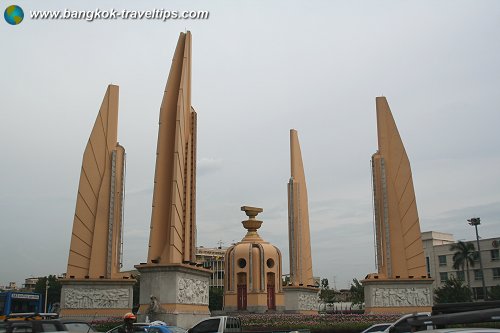
Democracy Monument (29 August 2006)

Democracy Monument or Anu Sawari Pracha Tippatai is a public monument in the Banglamphu district of Bangkok. It is located in a roundabout, approximately half way between the Golden Mount and Wat Phra Kaeo, the Temple of the Emerald Buddha.
Democracy Monument commemorates the June 1932 military coup that established the constitutional monarchy and changed the name of the country from Siam to Thailand. The monument was commissioned by the military ruler of Thailand, Field Marshal Plaek Pibulsonggram @ Phibun, in 1939. In building the Democracy Monument, Phibun envision turning Thanon Ratchadamnoen into something like the Champs-Élysées, and the Democracy Monument acting as the metaphorical Arc de Triomphe. The monument was designed by Italian sculptor Corrado Feroci, who took up residence in Siam and changed his name to Professor Silpa Phirasri @ Bhirasi. He also designed other notable monuments including the Rama 1 Statue at Memorial Bridge and the Victory Monument. The architect was Mew Aphaiwong, whose brother Khuang Aphaiwong was a member of Phibun's regime.
The construction of the Democracy Monument as well as the widening of Thanon Ratchadamnoen was met with much resentment. It stood as a symbol of the heavy-handedness of the military towards civilians. Local residents and shopkeepers, most of whom were ethnic Chinese, were evicted from their homes and businesses with only 60-day notices.
The dimensions of the monument are highly symbolic. It consists of four upright wings, each 24 meters high with a radius of also 24 meters, which stand of the date of 24 June when the coup took place. The four wings represents the four branches of the Thai armed forces - the army, navy, air force and police. At the centre, on top of two golden offering bowls, is a sculpture representing the Thai Constitution of 1932.
There used to be 75 small cannons around the outer ring of the monument. They were meant to stand for the year 2475 in the Buddhist calendar, corresponding to 1932, the year of the coup. At the base of two of the upright wings and water sprouts in the form of nagas. The sculptures at the base of the wings are military propaganda depicting the armed forces as the champions of democracy. In actuality, it is a distortion of the truth, for despite all intentions of 1932, by 1939, when the Democracy Monument was built, Thailand was in effect a military dictatorship. Totally absent from the Democracy Monument is the monarchy, which today is personified in the highly revered king. But in 1932, King Prajadhipok (Rama VII), uncle of the present king, was effectively swept aside in a coup while he was on holiday. The king went into exile and eventually abdicated rather than accept his country's degeneration into military dictatorship.
It is ironic that a monument set up by the self-justifying Phibun regime and was nothing about democracy but only by name, should generations later become the focus point for democracy rallies and demonstrations. This was the venue of the 14 October 1973 mass student demonstration which was brutally repressed by the military with the death of hundreds of protesters. History repeated itself in 1992 when scores were killed at the Democracy Monument when the protested against General Suchinda Kraprayoon's regime. These rallies for democracy have given the monument the legitimacy it lacked in its early history.
Getting there
The Democracy Monument is located in Banglamphu. At the moment, there are no Skytrains or MRT to Banglamphu, so the best way to reach the Democracy Monument is by taking the taxi. You should also use your trip to visit other nearby sights.List of Monuments in Bangkok; list of Districts of Bangkok
 Latest updates on Penang Travel Tips
Latest updates on Penang Travel Tips
 Map of Roads in Penang
Map of Roads in Penang
Looking for information on Penang? Use this Map of Roads in Penang to zoom in on information about Penang, brought to you road by road.
Copyright © 2003-2025 Timothy Tye. All Rights Reserved.

 Go Back
Go Back